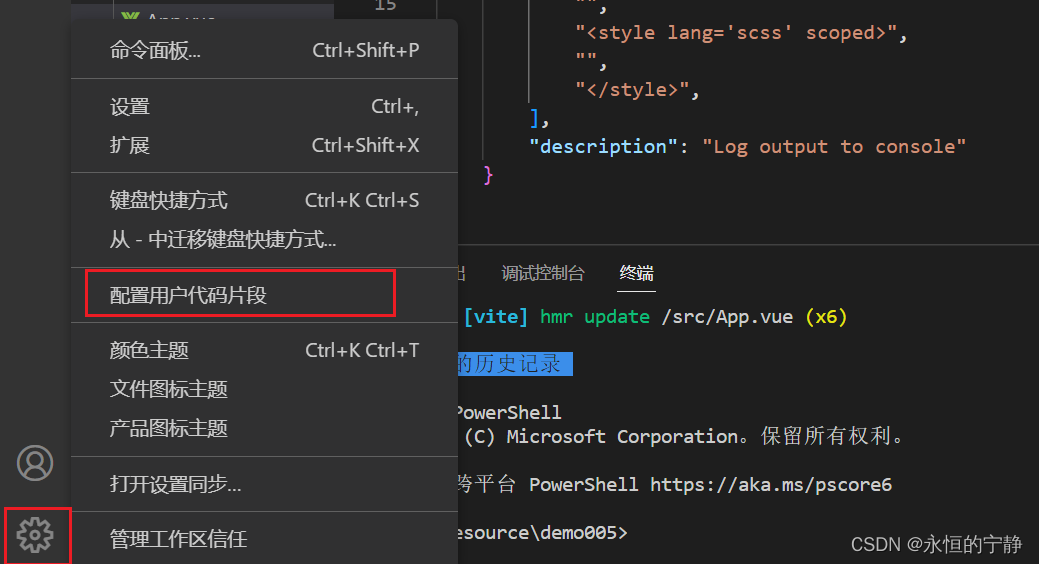一、为什么要用vite?
vite:构建工具,对标webpack
vue create vue-project 基于webpack构建
vite速度比webpack快。
二、用vite搭建vue3项目
npm init vite@latest # 使用vite构建
npm init vue@latest # 使用webpack构建,专门用于vue,有很多配置不需要我们配了
三、模板语法与指令
插值{{}}中可以放一些函数及计算
<template>
<div>
<!-- 在插值表达式 -->
{{message.split(',').map(v=>`${v}888`)}}
</div>
</template>
<script setup lang="ts">
const message:string = 'h,e,l,l,o'
</script>
<style scoped>
</style>
v-if(隐藏节点dom),v-show(操作css)
<template>
<div>
<span v-show="flag">hello,vue!</span>
<!-- 可以使用比较表达式 -->
<span v-show="2>1">hello,vue!</span>
<span v-if="3>1">hello,vue!</span>
</div>
</template>
<script setup lang="ts">
const flag:boolean = false
</script>
<style scoped>
</style>
- v-html 用来展示富文本
- v-on 简写@ 用来给元素添加事件
- v-bind 简写:用来绑定元素的属性Attr
- v-model 双向绑定
- v-for 用来遍历元素
四、为什么要有虚拟DOM
dom上的属性是非常多的,直接操作DOM非常浪费性能,用JS的计算性能来换取操作DOM所消耗的性能。操作JS是非常快的。
五、Vue3 ref
ref 接受一个内部值并返回一个响应式且可变的ref对象。ref对象仅有一个.value property,指向该内部值。
在.vue文件中输入vue3快速模板的设置方法

输入vue.json进行配置
{
"Print to console": {
"prefix": "vue3",
"body": [
"<template>",
"",
" <div></div>",
"",
"</template>",
"",
"<script setup lang='ts'>",
"import { ref, reactive } from 'vue'",
"",
"</script>",
"",
"<style lang='scss' scoped>",
"",
"</style>",
],
"description": "Log output to console"
}
}
<template>
<div>
<span>{{Person.name}}</span> <br>
<button @click="change">点击更改</button>
</div>
</template>
<script setup lang='ts'>
import { ref, reactive, isRef } from 'vue'
// ref的interface
import type { Ref } from 'vue'
// 直接类型推导
// const Person = ref({name: '张三'})
// 定义一个类型
type P = {
name: string
}
// ref可以定义一个泛型,约束里面定义的对象。
// const Person = ref<P>({name: '张三'})
const Person:Ref<P> = ref({name: '张三'})
const change = ()=>{
// 需要加上value
Person.value.name = '李四'
// isRef函数,判断是否是ref对象
console.log(isRef(Person))
}
</script>
<style lang='scss' scoped>
</style>
使用ref读取dom
<template>
<div>
<span ref="spanhello">hello</span> <br>
<button @click="change">点击更改</button>
</div>
</template>
<script setup lang='ts'>
import { ref, reactive, isRef } from 'vue'
// spanhello需要和html中的ref属性一致
const spanhello = ref<HTMLSpanElement>()
const change = ()=>{
// 读取dom节点的innerText
console.log(spanhello.value?.innerText)
}
</script>
<style lang='scss' scoped>
</style>
六、Vu3 reactive
ref和reactive都是将我们的变量变成响应式
reactive源码约事了我们的类型,用来绑定复杂数据类型如对象、数组,不可以绑定普通的数据类型。
案例一:
<template>
<div>
姓名:{{Person.name}} <br>
年龄: {{Person.age}} <br>
</div>
</template>
<script setup lang='ts'>
import { ref, reactive, isRef } from 'vue'
// ref 支持所有的类型,reactive引用类型 Array Object Map Set
// ref 取值 赋值 都需要加.value,reactive是不需要.value
type P = {
name: string,
age: number
}
// 用泛型或推导类型都ok
const Person = reactive<P>({name: '张三', age: 18})
</script>
<style lang='scss' scoped>
</style>
案例二:
<template>
<div>
<form action="/">
姓名:<input type="text" v-model="form.name"> <br>
年龄:<input type="text" v-model="form.age"> <br>
<button @click.prevent="submit">提交</button>
</form>
</div>
</template>
<script setup lang='ts'>
import { ref, reactive, isRef } from 'vue'
// reactive经常用来绑定一些表单数据,实现响应式,数据双向流动
let form = reactive({
name: '',
age: 0
})
const submit = () => {
console.log(form)
}
</script>
<style lang='scss' scoped>
</style>
案例三:
<template>
<div>
<ul v-for="item in list">
<li>{{item}}</li>
</ul>
<button @click="add">添加</button>
</div>
</template>
<script setup lang='ts'>
import { ref, reactive, isRef } from 'vue'
// reactive经常用来绑定一些表单数据,实现响应式,数据双向流动
// reactive是一个proxy,不能直接赋值,直接赋值就不是proxy了,破坏了响应式
let list = reactive<string[]>([])
const add = () => {
// list.push("hello") 这样写没有问题
// 这里如果来个异步,模拟从接口获取数据
setTimeout(()=>{
let res = ['hello', 'vue', 'reactive']
//list = res
//list中的数据有改变,但页面并没有被渲染
//因为上一个list=res将proxy list的类型覆盖了
//解决方案一:使用解构
list.push(...res)
console.log(list)
}, 2000)
}
</script>
<style lang='scss' scoped>
</style>
不使用解构就想直接赋值
<template>
<div>
<ul v-for="item in list.arr">
<li>{{item}}</li>
</ul>
<button @click="add">添加</button>
</div>
</template>
<script setup lang='ts'>
import { ref, reactive, isRef } from 'vue'
// reactive经常用来绑定一些表单数据,实现响应式,数据双向流动
// reactive是一个proxy,不能直接赋值,直接赋值就不是proxy了,破坏了响应式
let list = reactive<{arr:string[]}>({arr:[]})
const add = () => {
// list.push("hello") 这样写没有问题
// 这里如果来个异步,模拟从接口获取数据
setTimeout(()=>{
let res = ['hello', 'vue', 'reactive']
//list = res
//list中的数据有改变,但页面并没有被渲染
//因为上一个list=res将proxy list的类型覆盖了
//使用对象 原则只要不覆盖list 导致proxy类型改变即可
list.arr = res
console.log(list)
}, 2000)
}
</script>
<style lang='scss' scoped>
</style>
七、toRef toRefs toRaw
toRef: 如果原始对象是非响应式的就不会更新视图,数据是会变的。
toRef: 将响应式对象的一个属性拿出来再做响应式
<template>
<div>
{{name}}--{{age}}--{{hobby}}
{{person.name}}--{{person.age}}--{{person.hobby}}
<button @click="change1">更改1</button>
<button @click="change2">更改2</button>
</div>
</template>
<script setup lang='ts'>
import { toRef, reactive, toRefs, toRaw } from 'vue'
let person = reactive({name: '张三', age: 20, hobby: 'footbar'})
// 将一个响应式对象的属性拿出来再做响应式
// const hobby = toRef(person, 'hobby')
// 应用场景,解构出来赋给一个函数做为参数
// toRefs的应用,解构出来的属性和对象的属性一一对应
// 解构出来的name和person.name的值一样,你变我也变
let {name, age, hobby} = toRefs(person)
const change1 = ()=>{
person.name = '王五'
}
const change2 = ()=>{
// 解构出来的属性要赋值须加上.value
hobby.value = 'beauty'
}
</script>
<style lang='scss' scoped>
</style>
toRaw
<template>
<div>
<button @click="change">更改1</button>
</div>
</template>
<script setup lang='ts'>
import { toRef, reactive, toRefs, toRaw } from 'vue'
let person = reactive({name: '张三', age: 20, hobby: 'footbar'})
// toRaw将响应式对象改成不是响应式的对象
let person1 = toRaw(person)
const change = () => {
console.log(person, person1)
}
</script>
<style lang='scss' scoped>
</style>























 4778
4778











 被折叠的 条评论
为什么被折叠?
被折叠的 条评论
为什么被折叠?










